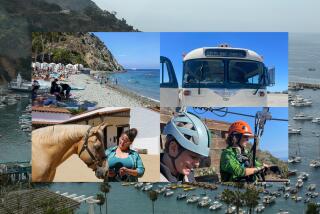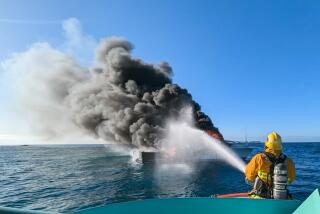Catalina’s Floating Lifeline : Almost Everything Islanders Eat, Build or Sell Comes From Mainland by Barge
It is a thought that may not cross the mind of the average tourist to Santa Catalina Island, but almost everything he buys or eats was sent over from the mainland.
And more than likely, that souvenir T-shirt or those fresh salad vegetables made the 22-mile crossing to the island by barge.
Catalina’s most vital links to the mainland are based at Berth 184 in Los Angeles Harbor.
Dubbed Islander and Islander II, the two 128-foot-long barges transport food, fuel, clothing, cars, construction materials and just about everything else it takes to live in Avalon or Two Harbors, the even more isolated community on the other side of the island.
Their task is awesome: to supply the necessities of life to Catalina’s more than 3,000 year-round residents and as many as 15,000 visitors a day during the peak summer tourist season.
Land at Pebbly Beach
Making more than 200 round trips annually from their Wilmington berth to their island landing near Pebbly Beach Road, about a mile east of Avalon, the flat-bottomed boats are Catalina’s umbilical tie to “overtown.”
The barges, pulled by tugboats across the channel, make round-trip crossings at least five times a week in summer and three times a week in winter, depending on the tides and the whims of the weather, said Jim Radcliffe, vice president of Catalina Freight Lines.
“The barge is definitely the one and only major necessity on the island,” said Sally Freeman. She and her husband own a wholesale food supply company as well as Fred and Sally’s, one of Avalon’s two supermarkets.
Catalina’s remoteness is one of its greatest attractions, but it also means that residents and merchants must rely heavily on sea transportation, particularly for items like fresh fruit, vegetables and other perishables. Mail and some small packages are delivered by air.
In June, the Santa Catalina Island Co. announced a sweeping, 15-year development plan that will overhaul much of Avalon. The plan includes construction of hotels, a fire station and, eventually, a City Hall and civic complex. Once development begins, the barges’ importance to the island’s existence will increase, since developers rely on them to transport building materials.
Isolation Is Challenge
“One of the challenges of building over here is our geographic isolation, and the need to plan out exactly how the construction process is going to work, because it’s totally different from the mainland,” said Ron Doutt, vice president of the Santa Catalina Island Co. “You can figure anything built on Catalina is going to cost at least 50% more (than on the mainland).”
The logistics include coordinating the arrival of the right kinds of construction workers with the right goods, he said.
“If you forget an order of 4-by-4s or you forget some bolt, you can’t go down and just pick up what you’ve forgotten,” Doutt said. “You’ve got to wait for the next barge, and hope that is a priority item and will get on.”
Whether a last-minute order makes it onto the barge depends on the item--food and fuel take priority--its size, and whether the barge is full, said Leo Hernandez, who manages freight company operations in Wilmington.
The barge is a “roll-on, roll-off” operation, meaning that already loaded truck trailers are driven over a ramp directly onto the barge, where the trailers are disconnected from the truck and parked for the cross-channel ride to Avalon. There, the trailers are either unloaded at the company’s warehouse or reconnected to a truck and hauled to their island destination.
“In those trailers, we put all of the island’s building products, all of the food services, all of the clothing--everything,” said Ed Fine, manager of barge operations at Pebbly Beach Road in Avalon. “Everything that it takes for a community to live.”
The barge also carries nearly 3 million gallons of fuel per year, including diesel fuel to operate the Southern California Edison Co. power plant on the island, Radcliffe said.
Operated Since 1958
Catalina Freight Lines, which employs about 18 people in Avalon and Wilmington during the peak summer season, has operated the barges since 1958, Radcliffe said. Before that, the Santa Catalina Island Co. transported goods by steamer.
Catalina Freight, whose rates and operation are regulated by the state Public Utilities Commission, charges $6.77 per 100 pounds of freight, with higher rates for furniture, vehicles and other bulky items. The barges’ sheer weight--326 tons unloaded--makes crossing possible in all but the most stormy seas, officials said.
Residents say barge service is reliable--except when nature does not cooperate.
During particularly bad weather, such as a series of storms during January, 1988, the barges may be out of commission for two or three days, freight company officials said. Or, if the tide is not high enough, tug operators are unable to bring a barge close enough to shore to extend the loading ramp.
At such times, island residents and merchants either cope with shortages or find ways around them.
“We have problems getting goods once in a while when the weather is scuzzy or the tides aren’t right,” Freeman said. “We’ve had occasions where a barge can’t come over for three days, and that’s very hard. The store panics when they see the weather is getting a little scuzzy because the local people start hoarding milk and bread.”
If their store runs out of such perishable items, Freeman said, her husband flies the couple’s plane to the mainland to pick up more.
Other residents who can’t get what they need at Avalon’s stores find their own alternative sources.
Like John W. R. Windle, whose wife, Jean, ran out of a preserving solution when she was canning fresh peaches.
“I got my kids to send it over for me,” Windle said.
More to Read
Sign up for The Wild
We’ll help you find the best places to hike, bike and run, as well as the perfect silent spots for meditation and yoga.
You may occasionally receive promotional content from the Los Angeles Times.






